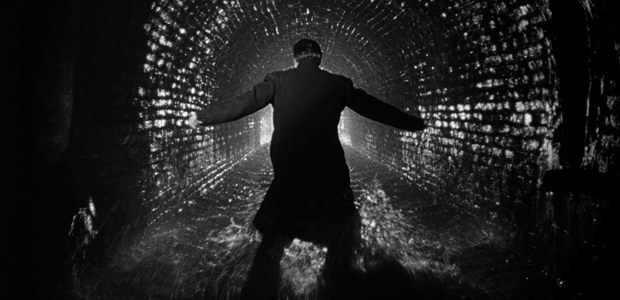The Third Man begins with a voice-over telling us about the city that the movie is set in: a Vienna that’s been devastated by a world war and sliced up by the victors. Joseph Cotten‘s Holly Martins, a penny-starved author of pulp westerns, arrives in this Vienna at the behest of his friend, Harry Lime who has offered him to work together. Within minutes of his arrival, Martins is redirected to Harry Lime’s funeral. He discovers that Lime has just died, run over by his own driver in front of his own apartment. While trying to uncover details of the accidental death, Martins at first learns that two men carried him from the road to the pavement, but digging further, he learns about a third man who helped carry the dead Harry Lime! And so begins the suspense behind one of the most celebrated film-noirs ever: Accident or Murder? Who is the murderer? How is the beautiful Anna, Lime’s bereaved actress-girlfriend, involved? And who, in all of Vienna, is The Third Man?!
Sixty years after its original release, The Third Man still works on most levels. Apart from the simple fact that there have been numerous tributes, references and spoofs that diminish the brilliance of some scenes, it is nevertheless a movie that exudes brilliance. The absolute highlight of the movie begins the third act, when we are finally shows Orson Welles in what becomes the most memorable scene (and singular shot) from the film. It begins with the camera following an unidentified person’s footsteps along the pavement of an empty road, inter-cut with a scene with Holly Martins in Anna’s apartment. The mysterious man (for he IS a man – the trouser-legs and shoes suggest it, and in all possibility, the Third Man) steps into an entrance’s arch-way that gives him a view of the apartment window, a dark shadow hiding his torso and face from us. When Martins eventually steps out of the apartment and walks along the road, he notices, from across, a cat shuffling at the mysterious man’s feet. Some shouting for identification, a light-switched on at a window upstairs & across, and we see a surprised, intrigued and smirking Orson Welles. Barely do we register his grand presence when Martins addresses him… as Harry Lime! Excuse me?! Who? How?! WHAT!
Many scenes exude such brilliance. The climax at the sewers, Lime’s attempt for freedom (fingers searching freedom through a grate) and final-shot of the movie: Anna walking up the road and apathetically past Martins without even a hint of a glance towards him. Small wonder the movie is a legend.
As well as the movie is written (suspense, suspense!), it is well-enacted and extremely well shot. The richness of Black in sharp contrast to the whites makes the visuals striking and mysterious. The wet black cobble-stones on the streets reflect light at their edges. The shadows that Harry Lime disappears into within the sewers are the blackest of black, suddenly illuminating him when lights are turned on him. Anna walks into and out of a shadow to change clothes when the Russian Military policemen arrive to arrest her. When the police wait in shadows to ambush Harry Lime, we see a balloon-seller walk from behind a building onto the street – but we see his large black shadow on the opposite wall first. The film is rich with many such glorious shots, some tilted to an askew angle, exploiting and excelling in its limitation of color. The Third Man also benefits from a marvelous background score. From the opening titles, played over the strings of a musical instrument (Wikipedia tells us that it is a zither), to the most memorable of sequences and the aforementioned climax, wine-bar-performer-made-music-composer Anton Karas provides the movie with an eerily apt score. The music resonates to each scene, matching the fabric of the movie perfectly.
A good movie tends to get most of the ingredients just right: story, visuals, music and performances. The Third Man gets ALL of them exactly right, and then involves one Mr Orson Welles.
Rating: 




